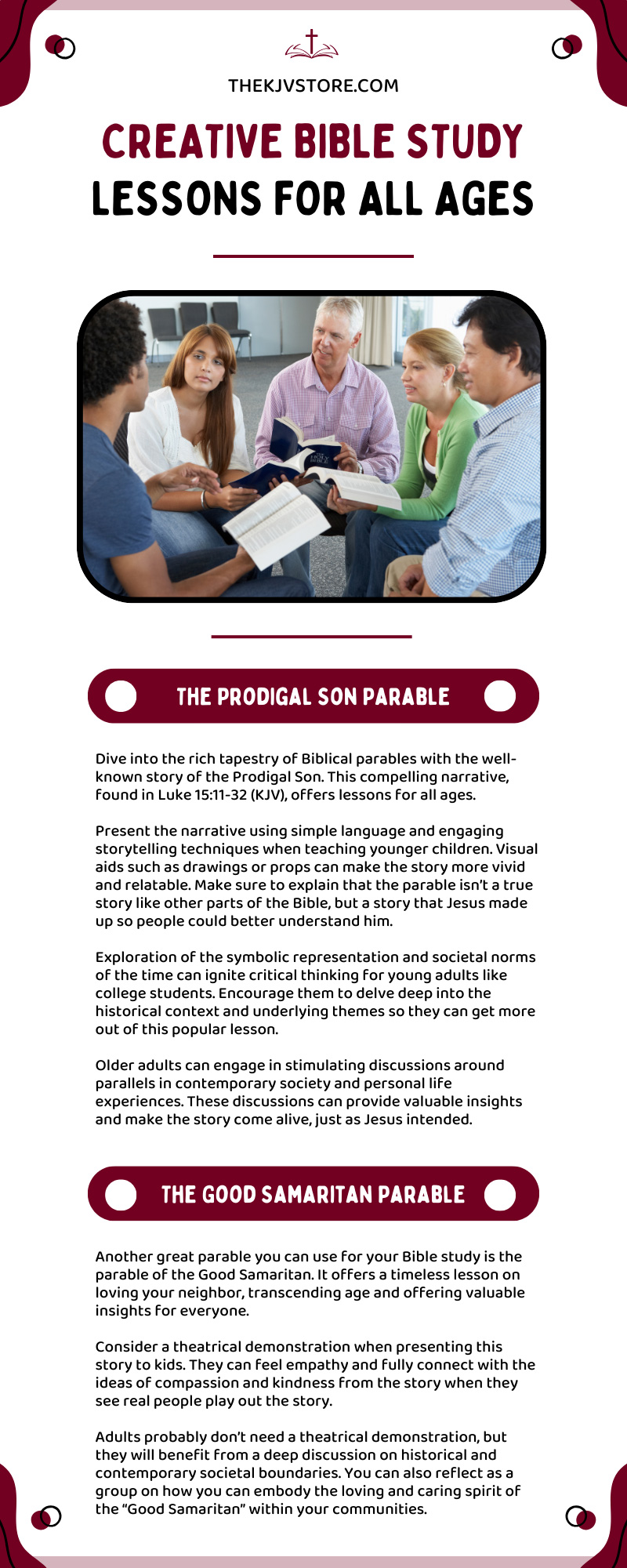7 Creative Bible Study Lessons for All Ages

Teaching Bible lessons is a great opportunity and a great challenge. Introducing these lessons to children who are still learning so much about the world and their faith is a big responsibility. Additionally, sharing these lessons with adults who grew up in church and think they already understand important stories is often frustrating.
The key to surmounting these big responsibilities and frustrations is to get creative. Illustrations and deep discussions can take the following seven creative Bible study lessons for all ages to a new level that everyone can learn from and enjoy.
The Prodigal Son Parable
Dive into the rich tapestry of Biblical parables with the well-known story of the Prodigal Son. This compelling narrative, found in Luke 15:11-32 (KJV), offers lessons for all ages.
Present the narrative using simple language and engaging storytelling techniques when teaching younger children. Visual aids such as drawings or props can make the story more vivid and relatable. Make sure to explain that the parable isn’t a true story like other parts of the Bible, but a story that Jesus made up so people could better understand him.
Exploration of the symbolic representation and societal norms of the time can ignite critical thinking for young adults like college students. Encourage them to delve deep into the historical context and underlying themes so they can get more out of this popular lesson.
Older adults can engage in stimulating discussions around parallels in contemporary society and personal life experiences. These discussions can provide valuable insights and make the story come alive, just as Jesus intended.
The Good Samaritan Parable
Another great parable you can use for your Bible study is the parable of the Good Samaritan. It offers a timeless lesson on loving your neighbor, transcending age and offering valuable insights for everyone.
Consider a theatrical demonstration when presenting this story to kids. They can feel empathy and fully connect with the ideas of compassion and kindness from the story when they see real people play out the story.
Adults probably don’t need a theatrical demonstration, but they will benefit from a deep discussion on historical and contemporary societal boundaries. You can also reflect as a group on how you can embody the loving and caring spirit of the “Good Samaritan” within your communities.
The Creation Story
Immerse your Bible study in the creation narrative found in Genesis 1-2. This story, filled with divine wonder, offers enriching lessons for audiences of all ages.
Consider crafting a seven-day activity plan for elementary-aged children. This is a popular method for Vacation Bible School, which often lasts a week. You can break the craft up however you see fit. Each day can correspond with one of God’s creations, providing a tangible connection to the story and fun craft options.
Young adults can delve into this narrative using a more analytical approach. Exploring the theological and scientific debates surrounding the creation story not only fosters their analytical skills but also broadens their understanding of diverse perspectives. They will need this practice as they enter the vast, secular world.
Meanwhile, older adults should reflect on the importance of rest. God resting on the seventh day (Genesis 2:2, KJV), reminds us of the vital role rest plays in our lives. Instruct your Bible study group to brainstorm ideas on how they can better incorporate Biblical rest into their daily lives.
Noah’s Ark
Embark on a journey into the heart of obedience and faith with the story of Noah’s Ark, found in Genesis chapters 6-9 (KJV). This engaging narrative serves as an excellent lesson for kids and adults.
Consider using animal toys or drawings when introducing this story to younger children. Visual aids bring the narrative to life, making it more engaging for them. You can give each child an animal toy so they can find their pair and walk to a designated “Noah’s Ark” section of the room.
Once children reach their teenage years and early adulthood, they already know the basics of Noah’s Ark. Have them delve deeper into the story, discussing the implications of blind faith and obedience. This critical discussion broadens their understanding of the complex interplay between faith and reason.
This story provides an opportunity for introspection for adults. Encourage them to share personal experiences related to the themes of obedience and faith.
David and Goliath
Venture into the inspirational narrative of David and Goliath, a story that offers a powerful lesson on overcoming challenges. You can find this tale in 1 Samuel 17 of the King James Bible.
Children probably won’t grasp the complexities of this historic battle, but you can focus in on David’s courage and trust in God. Implement role-play as an effective strategy for driving these points home. Using interactive techniques like role-play brings the story to life and allows children to actively engage with the narrative. After role-playing, discuss the challenges they can overcome if they are courageous and trust God.
Adults of all ages can delve into the psychological aspects of facing fears, discussing how David’s courage and faith influenced his victory. This discussion encourages people to confront their fears and understand the power of mindset. You can lead a time of personal discussion afterward where people can share fears they have and hope to overcome.
The Nativity Story
Engage with the captivating narrative of the Nativity, an enriching Bible story that resonates with all ages all year long. While you can find this story in all the Gospels, we recommend the detailed one from Luke 2:1-20 (KJV).
Most children won’t understand terminology such as census and virgin, so you can focus on the birth of Jesus and what his birth means for humanity. You can also introduce the concept of the Trinity, although this is easier for older children to grasp.
Adults should explore the deeper themes of faith, humility, and divine intervention we can learn from the Nativity. Take the time to also explore the historical and cultural aspects, such as how a government census helped fulfill Biblical prophecies.
Paul’s Conversion
The story of Paul’s conversion is a compelling testament to the possibility of change. Found in Acts 9:1-19 (KJV), people of all ages will appreciate learning about how God can change and use them.
We suggest using a theatrical rendition again when sharing this story with children. Doing so will help them understand how drastic and incredible Paul’s conversion was. While the children haven’t committed atrocities like Paul, explain that Jesus creates similar changes in us when we accept him as Lord and Savior.
Adults should examine the themes of forgiveness and redemption, exploring how Paul’s journey manifested these concepts. This discussion encourages introspection and fosters an understanding of the power of change. Older adults may have insights about how God saved and changed them.
These seven creative Bible study lessons for all ages can help you reach children, young adults, and older adults alike. The KJV Store can help if you need Bibles to help you with this outreach. Our wide-margin KJV Bibles are great for teaching and keeping your teaching notes close by.

